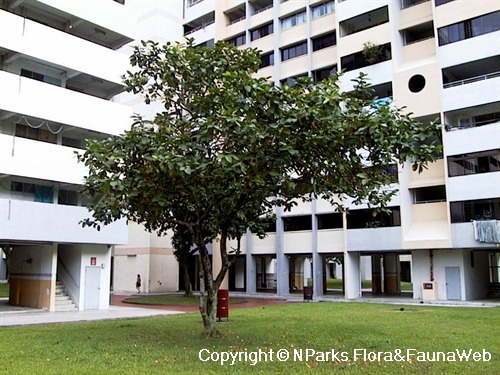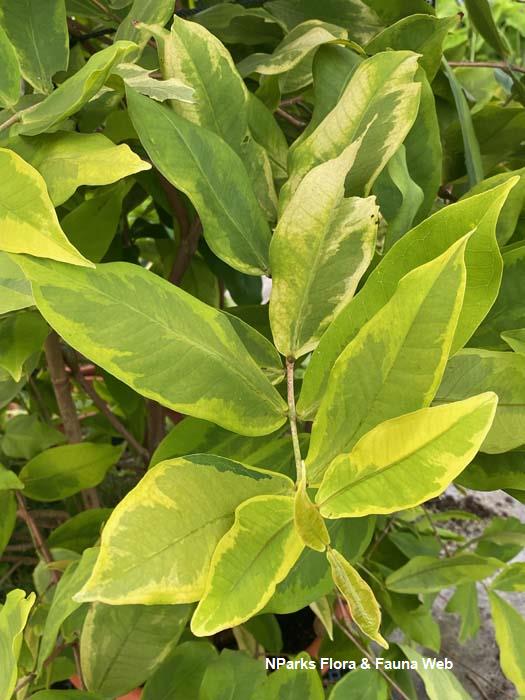
Back
Syzygium aqueum (Burm. f.) Alston
| Family Name: | Myrtaceae |
| Synonyms: | Eugenia aquea Burm.f. |
| Common Name: | Jambu Air, Water Apple, Jambu Air Mawar, Water Rose Apple, Watery Rose Apple, Water Cherry, Java Apple, Bell Fruit, Jambu Ayer, Jambu Chili, 水莲雾 |
Name
Classifications and Characteristics
| Plant Division | Angiosperms (Flowering Seed Plants) (Dicotyledon) |
|---|---|
| Plant Growth Form | Tree (Small (6m-15m)) |
| Lifespan (in Singapore) | Perennial |
| Mode of Nutrition | Autotrophic |
| Plant Shape | Irregular |
| Maximum Height | 5 m to 10 m |
| Maximum Plant Spread / Crown Width | 5 m to 8 m |
| Tree or Palm – Trunk Diameter | 0 to 0 |
Biogeography
| Native Distribution | Southern India to Eastern Malaysia |
|---|---|
| Native Habitat | Terrestrial (Riverine) |
| Preferred Climate Zone | Tropical |
| Local Conservation Status | Non-native |
Description and Ethnobotany
| Others - Plant Morphology | Growth Form: Small evergreen tree with a dense, spreading crown. Habitat: This species occurs in moist tropical lowlands at altitudes of up to 1200 m. It grows best in climates that have a substantial dry season, but only in locations where they have ready access to water (eg., near a stream). Trunk: Trunk is short with branching occuring at about 1 m. Bark is brown and cracked. Foliage: Leaves are elliptic (5 - 23 cm long, 2.5 - 13 cm wide) with very short petioles. Flowers: Flowers (2.5 - 3.5 cm wide) are loosely arranged in small terminal or axillary clusters of 3 - 7. The bisexual flowers carry a large number of long stamens that give the flowers a fluffy appearance. They have a subtle fragrance. Fruits: Fruits are pear-shaped berries (5 cm long). The apex has a shallow cavity that is partially covered by 4 fleshy sepals. The skin is shiny, thin and waxy, while the flesh is white, juicy and crisp. Fruits are often seedless, but sometimes have 1 - 4 small seeds. In Singapore, the fruits are typically produced from January to March and from July to September. Landscaping: This plant is often planted in tropical parks and gardens. The pink to red fruits add colour and interest to the landscape. They can be used for screening, but should be planted on the outside of the screen. This species grows well when planted next to streams and ponds, because it requires a consistent supply of water. Cultivation: It grows best in open, tropical environments. Add well-rotted compost to the soil before planting. During the first 2 years of growth, the trees should be carefully weeded, watered and mulched with regular applications of manure or complete fertilizer. After the trees have become established, they require minimal maintenance. This species grows quickly and will produce fruits within 2- 3 years. For optimal fruit production, apply a compound fertilizer after harvesting the fruits. Propagation: In Southeast Asia, this species is typically propagated by air layering. It can also be propagated by cuttings, budding, marcotting and grafting. Although seeds can be planted, they do not store well and must be planted immediately. Etymology: The genus name "Syzygium" is derived from the Greek word "suzugos" which means joined. Syzygium used to be the name of a Jamaican plant species with paired leaves and branches. The species epithet "aqueum" refers to the juicy fruits of this species. It comes from the Latin word "aqueus" which means watery. |
|---|---|
| Ethnobotanical Uses | Edible Plant Parts : Edible Fruits Food (Fruit or Vegetable) Others: Food: The fruits are eaten fresh or preserved. It has a sweet, but slightly astringent taste. Sometimes, they are boiled briefly and sweetened with a little sugar. They are also added to soups and rojak (a fruit salad popular in Malaysia and Indonesia). The fruit skin is rich in Vitamin A. In the past, Malaysian women who had given birth would eat a ceremonial salad containing the fruit. Medicine: In Hawaii, an astringent bark decoction is used to treat thrush. Other: In Indonesia, young foliage is used to wrap snacks sold by street vendors. The reddish wood is hard and used to make ornamental objects. |
Landscaping Features
| Desirable Plant Features | Ornamental Fruits |
|---|---|
| Landscape Uses | General, Riverine |
| Thematic Landscaping | Economic Garden |
Fauna, Pollination and Dispersal
| Pollination Method(s) | Abiotic (Self-Pollinated) |
|---|
Plant Care and Propagation
| Light Preference | Full Sun |
|---|---|
| Water Preference | Moderate Water |
| Plant Growth Rate | Moderate |
| Rootzone Tolerance | Fertile Loamy Soils, Well-Drained Soils |
| Fertilizing | Apply a compound fertilizer after harvesting the fruits. |
| Propagation Method | Seed, Stem Cutting, Grafting, Marcotting, Air-Layering |
| Maintenance Requirements Remarks | Seedlings require intensive care, whereas established trees need little maintenance. |
| Planting Distance | 5 m to 7 m |
Foliar
| Foliage Retention | Evergreen |
|---|---|
| Mature Foliage Colour(s) | Green |
| Mature Foliage Texture(s) | Smooth |
| Foliar Type | Simple / Unifoliate |
| Foliar Arrangement Along Stem | Opposite |
| Foliar Shape(s) | Non-Palm Foliage (Elliptical) |
| Foliar Venation | Pinnate / Net |
| Foliar Margin | Entire |
| Foliar Apex - Tip | Caudate |
| Foliar Base | Rounded / Obtuse |
| Typical Foliar Area | Mesophyll ( 45cm2 - 182.25 cm2 ) |
| Leaf Area Index (LAI) for Green Plot Ratio | 3.0 (Tree - Intermediate Canopy) |
Non - Foliar and Storage
| Trunk Type (Non Palm) | Woody |
|---|---|
| Bark Colour(s) | Brown |
| Root Type | Underground (Tap Root) |
| Mature Bark Texture Remarks | Cracked Bark |
Floral (Angiosperm)
| Flower & Plant Sexuality | Bisexual Flowers |
| Flower Colour(s) | White |
|---|---|
| Flower Symmetry | Radial |
| Flowering Period | Hot & Dry Period |
| Flowering Habit | Polycarpic |
Fruit, Seed and Spore
| Mature Fruit Colour(s) | Pink, Red, White |
|---|---|
| Fruit Classification | Simple Fruit |
| Fruit Type | Fleshy Fruit , Berry |
Image Repository
Others
| Master ID | 1860 |
|---|---|
| Species ID | 3153 |
| Flora Disclaimer | The information in this website has been compiled from reliable sources, such as reference works on medicinal plants. It is not a substitute for medical advice or treatment and NParks does not purport to provide any medical advice. Readers should always consult his/her physician before using or consuming a plant for medicinal purposes. |













